tadao ando: punta della dogana museum in venice
it's not every day that a major new gallery opens in venice. after 14 months of restoration,
the punta della dogana museum by japanese architect, tadao ando opened to the public
on june 6th during the venice art biennale. its first exhibition 'mapping the studio: artists
from the françois pinault collection' was curated by alison m. gingeras and francesco bonami.
owned by french francois pinault, whose business empire also includes gucci and yves saint laurent,
he has one of the world's largest collections of contemporary art, of some 2,500 works,
of which 141 are destined for the punta della dogana's permanent collection.
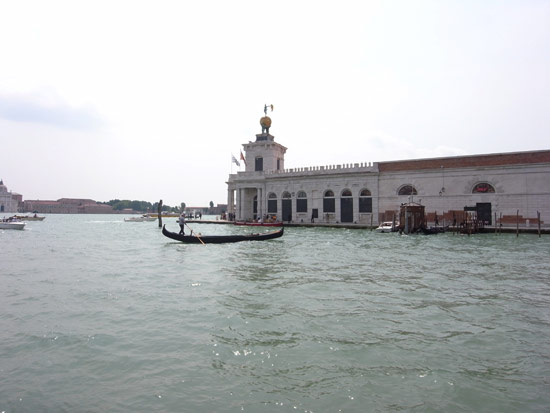
punta della dogana in venice, the gallery occupies a prime position.
image © designboom
for the past 30 years, the customs houses on punta della dogana have lain empty,
official impasses at the highest level saved the site from being turned into a hotel
or apartment block and, eventually, the solution for this art city was agreed.
at a cost of 20 million euros (28 million dollars), the new gallery will expand the
pinault foundation's presence in venice, who already owns palazzo grassi.
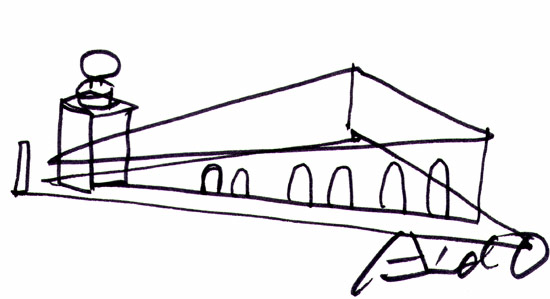
sketch by tadao ando
image courtesy palazzo grassi
the punta della dogana building in venice has a simple and rational structure.
the volume forms a triangle that directly corresponds to the shape of the tip of dorsoduro island,
whereas its interior space is dividend into long rectangles by a series of parallel walls.
with great respect for this emblematic building, all partitions that had been added during
previous renovations were thoroughly removed in order to recover its original form,
at the very beginning of its construction.
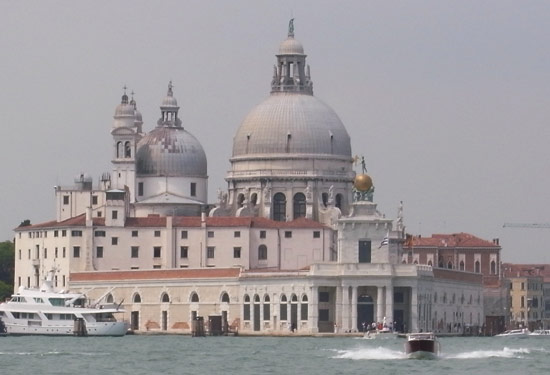
frontal view of punta della dogana (construction dates back to 1414 / rebuilt in 1675)
image © designboom
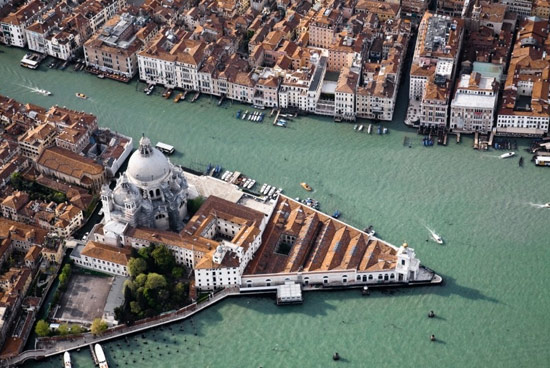
arial view
image courtesy palazzo grassi
the difficulties the architect encountered were largely due to the nature of the terrain –
for example, the foundation of the church required the sinking of some 1,200,000 oak piles.
the basic approach to the exterior renovation of the building consisted in carefully restoring
the original façades, except the openings which were entirely replaced through this renovation.
the project conceived by architect tadao ando included restoration work at several levels:
1. protection against water the base of punta della dogana is placed at 1.5 m above sea level.
this positioning is relatively high in venice and represents a natural protection against the tides
(to draw a comparison st. mark’s square is only 90 cm above sea level).
in order to improve the building’s overall waterproofing, a protective shell was installed –
also called a water hold-up tank – whose area is 2,500 sq. m. the hold-up tank is equipped
with watertight bulkheads along the entire perimeter and mobile protections for the doors,
thus ensuring protection against high water up to 2.10 m. thorough archaeological excavations
were carried out before building the protective shell, using the most innovative
technologies available.
2. structural consolidation and restoration of the masonry
the building’s structural consolidation required the installation of micro-piles
where the original foundations were insufficient (especially at the end of punta della dogana),
as well as the fastening of the brick corner walls. as far as the walls are concerned,
the architectural choice was to leave the masonry visible. bricks were adequately restored
by eliminating all decay factors and replacing the most seriously damaged elements
by adopting the traditional scuci-cuci (unstitching-stitching) method.
this entails damaged bricks being replaced one by one with intact bricks,
and laid with mortar of the same type as the original.
over 5,000 sq. m were restored using recycled bricks selected from
among those that offered the best guarantee for conservation purposes,
and that featured colour and shape as similar as possible to the original.
the stone facing outside the complex was restored using traditional methods.
it was structurally reinforced, where necessary, by inserting stainless steel bars,
new tie-beams and lime-mortar injections, in order to fasten the fractures and mend the
damage suffered by architectural and structural elements, as well as to eliminate the
empty spaces between the facing and support.
the exterior coating at the register of the gates’ arches was entirely recovered and restored.
the heavy existing damage due to biological agents was inactivated by means of reiterated
biocidal treatments which effectively contributed to the recovery of the surface.
the rusticated façade, made of bricks covered in plaster, was selectively restored
by rebuilding the plaster where the bosses were intact; otherwise, bricks, adequately restored,
were left in full view.
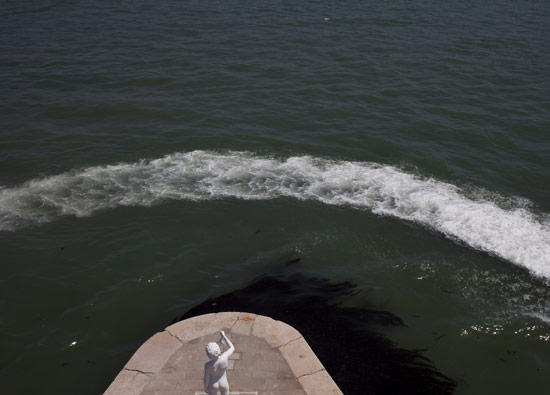
'boy with frog' sculpture by charles ray, 2009
cast stainless steel and acrylic polyurethane
image courtesy palazzo grassi
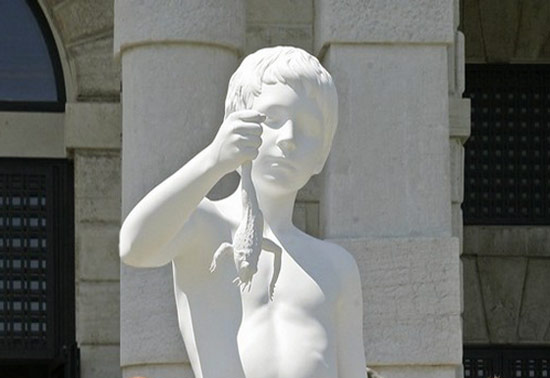
'boy with frog' sculpture by charles ray, 2009
venice's new landmark is 2,4 meters / eight-foot tall.
image © designboom
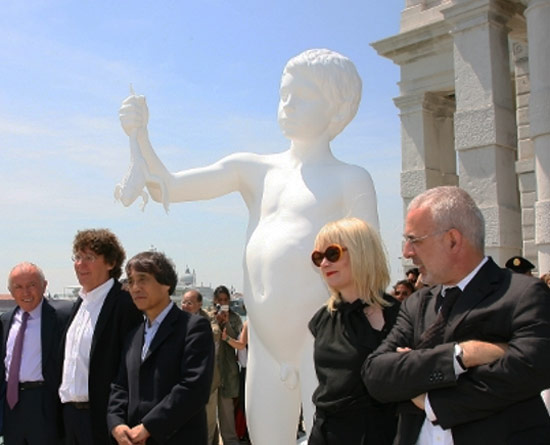
from left to right: françois pinault with charles ray and tadao ando, curators alison m. gingeras and francesco bonami
image courtesy palazzo grassi
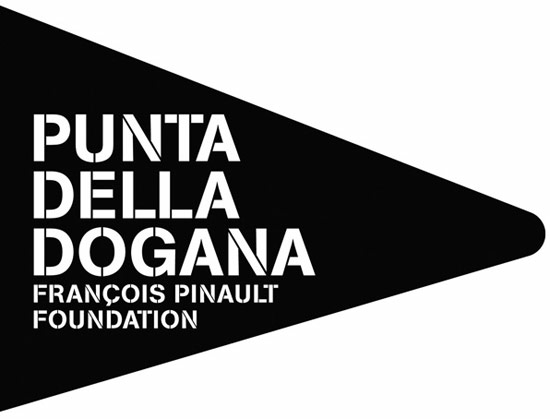
logo of punta della dogana museum
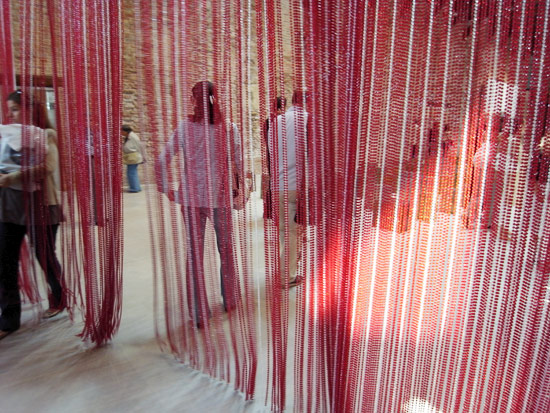
'untitled (blood') by felix gonzalez-torres,1992
curtain with plastic beads, metal rod
image © designboom
a curtain of red and clear beads, gonzalez-torres wanted the viewer not only to look
at the present piece. gonzalez-torres remembered seeing the results of his lover ross laycock's
disappointing HIV blood-tests, "I said to him, 'honey, this is your blood. right here. this is it.' . .
and it was even more frightening because all the numbers could be easily reversed.
it is a total abstraction; but it is the body. it is your life but also to walk through it and touch it.'
ross laycock died in 1991 after a prolonged AIDS related illness.
in this same year gonzalez-torres' father died as well. like much of his work from this period,
"untitled" (blood) is an elegiac memorial to love and loss.
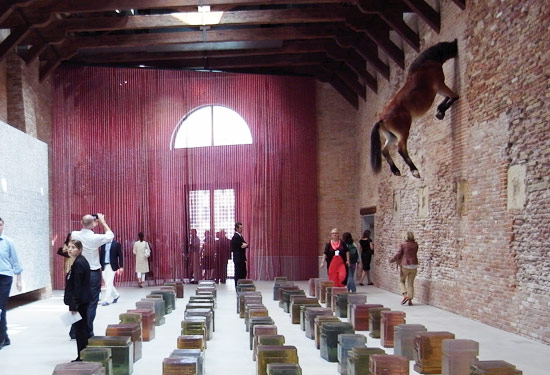
general view of the entrance
image © designboom

'untitled' by maurizio cattelan, 2007
taxidermied horse: horse hide, fiberglass, resin
image © designboom

'untitled (one hundred spaces)' by rachel whiteread, 1995
resin, 100 units
image © designboom

general view
image © designboom
through exposing the brick walls and wooden roof trusses, the space retrieved its energy
and the memories of the former sea customs were revived.
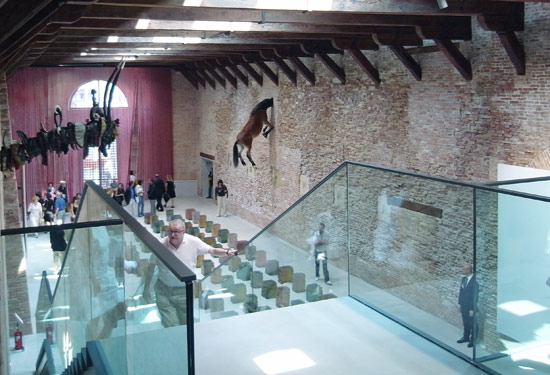
stairs to top floor
image © designboom
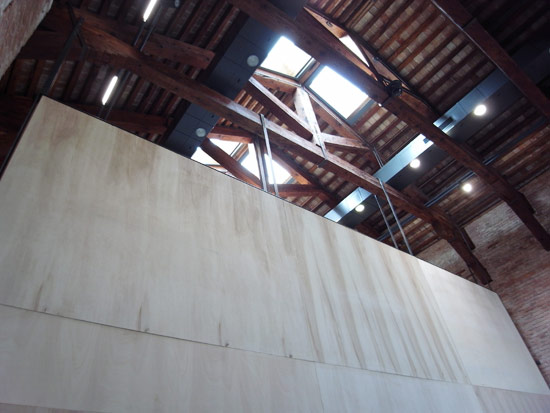
wall and ceiling
image © designboom
the building’s original roofing was entirely restored. the 130 trusses constituting the structure’s
original skeleton were almost entirely recovered. the recovery and consolidation treatment of
the wooden surface amounts to nearly 9,000 sq. m of wood (including the floor framework).
skylights permit the use of natural light in the museum’s halls. 90,000 tiles were laid on
the roof, around 50% of which were original; it was also possible to recover about 50,000 out
of 80,000 tavelle (thin quarries made of fired brick).

sketch by tadao ando
image courtesy palazzo grassi
the work of restoration had to remove the unwanted accretions that had accumulated over time,
with the new partition walls, stairs, walkways and service facilities all clearly identified as such.
in effect, there is no attempt to disguise these new additions within the old body of the structure.
instead, there is a continual play of juxtaposition – almost as if ando’s intention were to insert
within the ancient building new volumes and levels that seem to mark out the stratifications
added over time, organising them into a veritable spectacle of the structure’s own history.
in the center of the building, a square space spans over two rows as a result of an earlier
renovation. tadao ando inserted a 'concrete box' that dramatically transformed the space.

drawing by tadao ando studio
image courtesy palazzo grassi
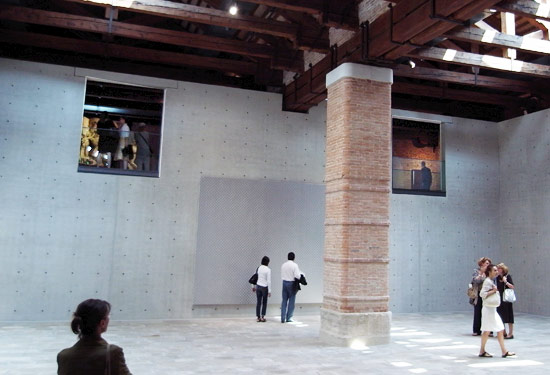
general view
image © designboom
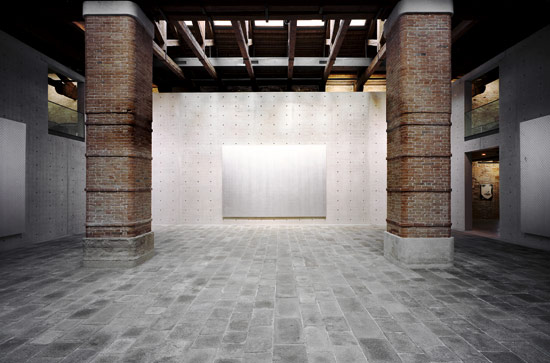
general view
image courtesy palazzo grassi
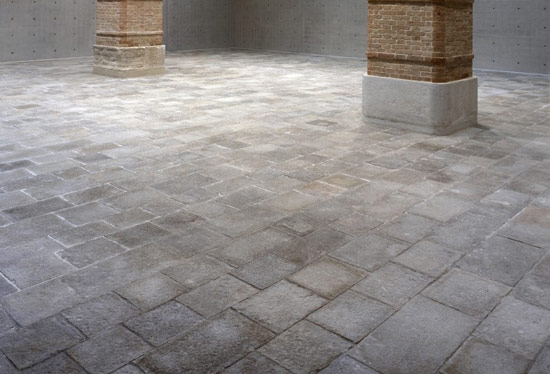
image courtesy palazzo grassi
in order to create a rich materic effect with the elements in architectural concrete,
and offer a token of the past, tadao ando selected the traditional venetian floor
(the so-called masegni) for the centre of the cube. elsewhere, the floors were made
of cement (ground floor) and linoleum (first floor). the floor heating system includes
over 28 km of coils circulating hot water.
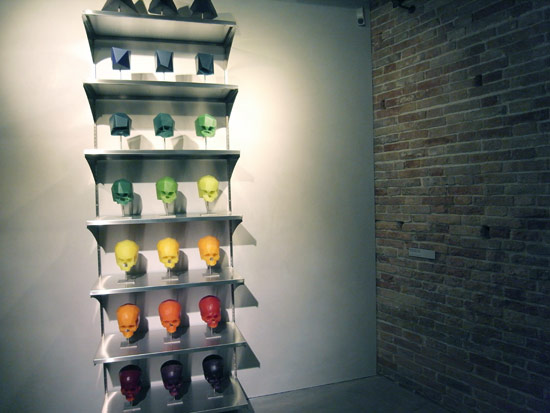
'skull spectrum' by mathew day jackson, 2009
image © designboom
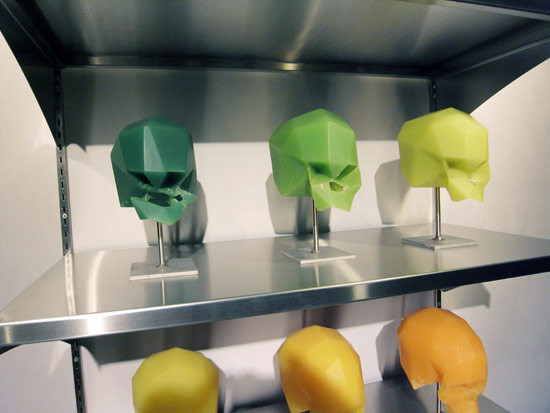
skull morphing into a tetrahedron, through a spectrum of colors
image © designboom
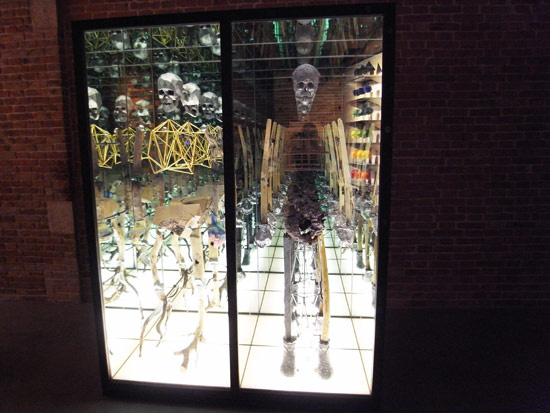
'dymaxion skeletons' showcases by mathew day jackson, 2008
image © designboom
though the skeleton is dead, it is strong and walks upright.
its hands seem capable of movement, gesture and construction.
the skull, though made of poisonous lead, surmounts the golden geodesic rib cage.
the dymaxion skeleton presents a utopia of being: the utopia of the body as a vehicle for consciousness.
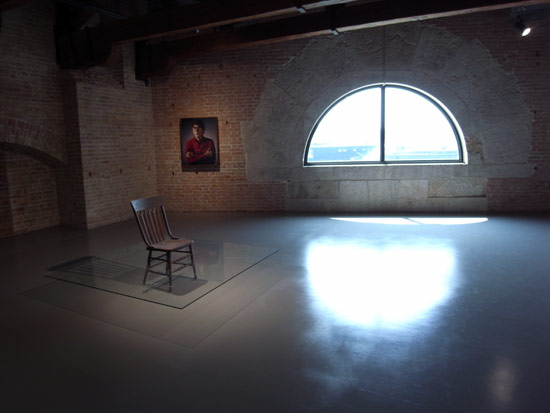
general view
image © designbom

'fucking hell' by jack and dinos chapman, 2008
plastic and mixed media (9 parts)
image © designboom
9 immense tabletop tableaus, peopled with over 30,000 remodelled, 2-inch-high figures,
many in nazi uniform and performing egregious acts of cruelty. the work combined historical,
religious and mythic narratives to present an apocalyptic snapshot of the twentieth-century.
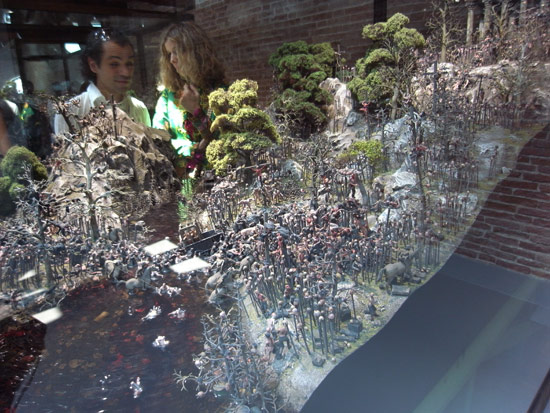
detail of showcase of 'fucking hell' by jack and dinos chapman,
image © designboom
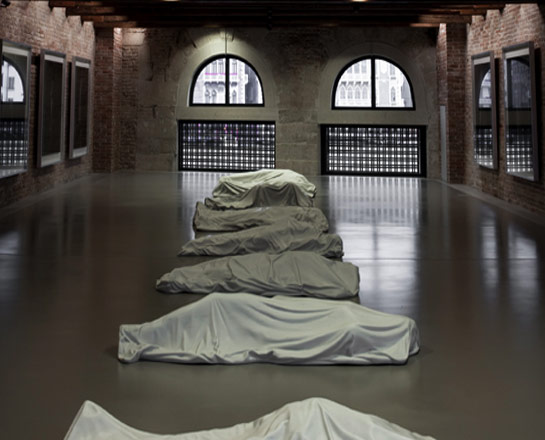
'all' by maurizio cattelan, 2008
9 sculptures of white carrara marble, a stark homage to the victims of the sicilian mafia
image © designboom
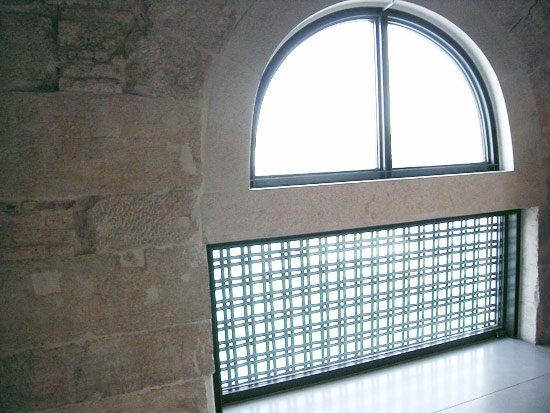
window
image © designboom
the design of the new doors and windows, though very modern, effectively employed venetian
traditional craft.
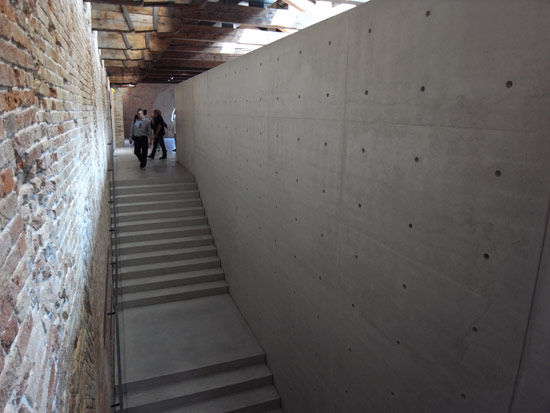
stairs
image © designboom

- jugendstil (axial age), 2005
- neo byzantium (axial age), 2005
- forward (axial age), 2007
- determination of the position: here it is (axial age), 2007 by sigmar polke
image courtesy palazzo grassi
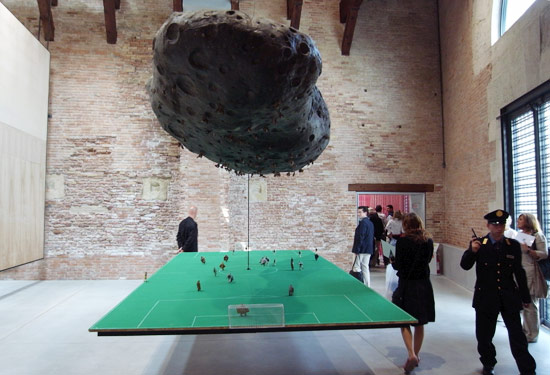
'a football match of june 14th 2002' by huang yong ping, 2002
the work shows women in burkas playing football with US soldiers on a field suspended under a bat-infested cave roof.
image © designboom
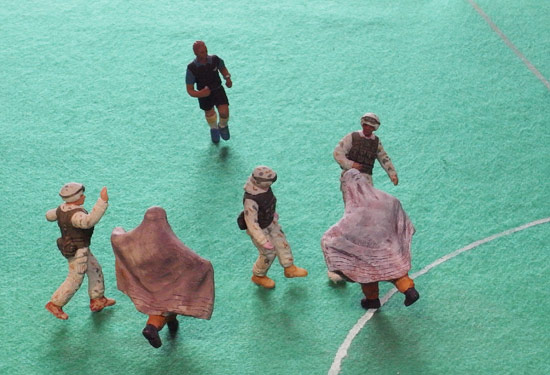
detail of 'a football match of june 14th 2002' / it's the date hamid karzai was elected afghan president
image © designboom
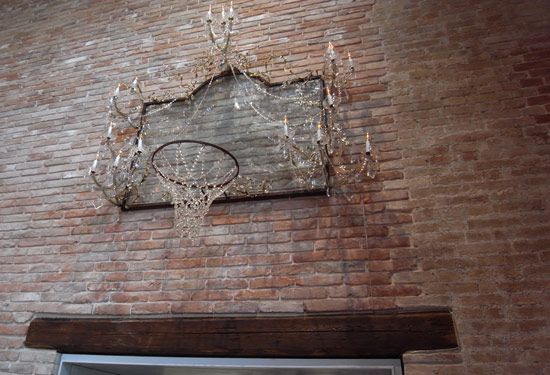
'untitled' by david hammons, 2000
swarovski crystals illuminate the basket ball hoop chandelier
image © designboom
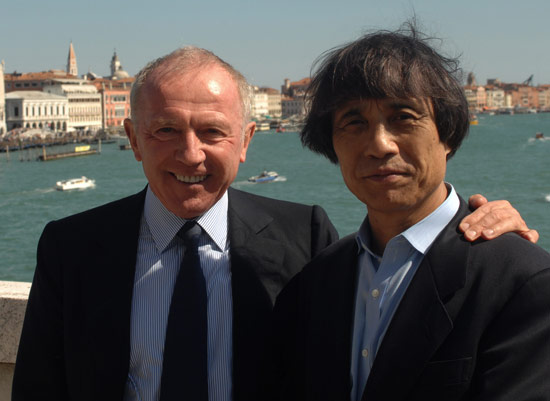
françois pinault with the architect tadao ando
image © graziano arici, courtesy palazzo grassi
|


































沒有留言:
張貼留言